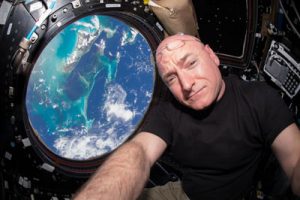Muscle Atrophy: An Astronaut’s Burden
Imagine blasting off into the final frontier, seeing the beauty of earth and witnessing the awe of the sea of stars. Amazing right? Now imagine being up there for almost a year. Still amazing… but a long stay-cation up in the great unknown could wear on someone mentally as well as take a great physical toll on the body. Take it from Scott Kelly, an American astronaut who recently returned from a record breaking 340-day mission aboard the International Space station.
As soon as Scott Kelly’s record breaking space adventure was coming to an end, the long process of his physical recovery was just getting started. Like other astronauts, he got taller in space, gaining 1 1/2 inches. When he came back to solid ground he lost that immediately. That gives you an idea of the incredible physical toll these astronauts undergo on any given mission. Even his skin is having a hard time adjusting to the gravity of earth. “it’s very, very sensitive. It’s almost like a burning feeling wherever I like sit or lie or walk,” Kelly said to the Associated Press.

Kelly was in prime physical condition before blasting off of our planet and fast forward 340 days and he can’t summon the strength to sink a basketball. In fact, simple tasks like putting on clothes have become exceptionally challenging endeavours as they cause his muscles to tighten up and become sore. Like most astronauts, Kelly is experiencing the symptoms of muscular atrophy.
What is Muscle Atrophy?
It’s not a muscular disease, but a disorder caused by the absence of gravity in the International Space Station which makes it nearly impossible to maintain muscle strength. Muscular atrophy involves the weakening and degradation of muscles due to a lack of physical activity. It’s not to say that astronauts aren’t active (they are in great physical condition) but in space, certain muscles we use on earth require less contracting as they work in a weightless environment. Without the force of gravity causing the muscles to contract, certain muscles decrease in strength, mobility and size. In fact, studies have shown that astronauts experience up to a 20% loss of muscle mass on spaceflights lasting five to 11 days.
It is vital that astronauts maintain their strength so they can perform critical mission tasks like going on spacewalks, installing new equipment, etc. In order to do this, they must exercise for two and a half hours per day. Watch as Canadian astronaut Chris Hadfield goes through his rigorous exercise routine.
On Earth, muscle atrophy occurs when humans experience lack of physical activity for long periods of time. It is common for those who have been bed ridden for a long period of time due to illness or injury. The recovery process can involve years of eating right and working out and can last longer depending on the severity of the degradation.
Tips for Overcoming Muscle Atrophy
The process involves a good deal of strength, will, and determination, and in no way is recovering from muscle atrophy impossible. If you or someone you know is attempting to overcome a form of muscle atrophy, it’s important to keep the following tips in mind.
Tip 1 – Get Some Expert Help/Advice
Astronauts have access to the best therapists and rehabilitation experts in the world. It’s important that you consult with an occupational therapist and a dietician so they can help you get back to your old physical self.
Tip 2 – Eating Correctly
Make sure your diet consists of lean proteins such as a chicken and fish and complex carbohydrates such as wheat pasta, whole grain bread and granola. Both of these contribute to the building of muscle.
Tip 3 – Easy Does it
Sometimes you will want to just get up and run, but you must understand your body isn’t physically ready to do the tasks you are used to accomplishing. It’s important to gradually work your way back to your old level of strength by not over exerting yourself. Over exerting yourself can cause further muscle strain that will halt the recovery process. When you start to feel the muscle soreness and start to deal with the pain involved, there are great solutions to relieving some of the muscle pain.
Tip 4 – Stick to it
It’s easy to give in to the frustration and the pain and give up, but when you stick to a goal you are going to be happier that you did in the end. In times you are frustrated by the process and find you aren’t staying focused on your end goal, you should try to surround yourself with positivity and find ways to get back on track. A lot of the frustration derives from lack of results and most commonly the muscle pains, aches and sores that occur.
Thankfully, we don’t have to search the ends of the universe to find remedies to deal with muscle pain. Therapists, medical professionals, and of course astronauts have found such remedies in topical pain relief formulas that have provided proven effective muscle pain relief for years.
MuscleCare offers it’s customers just that. Musclecare’s biological innovation sends magnesium immediately into the tissues to relax muscles and improve circulation that ultimately helps things get back to normal faster.
You don’t have to be an astronaut to use MuscleCare’s scientifically proven formula. In fact, many different types of people are using the product for all sorts of reasons. For those going through the aches and pains of recovering muscle tissue, or suffering from other ailments such as acute & chronic lower back pain, disc herniation, and knee pain and arthritis to name a few and are looking for some relief, we hope you the best of luck in your recovery. And Remember, when at moments where it gets to tough and the pain is too intense, know that MuscleCare is there to help!



